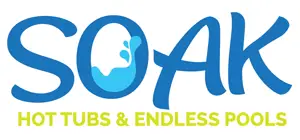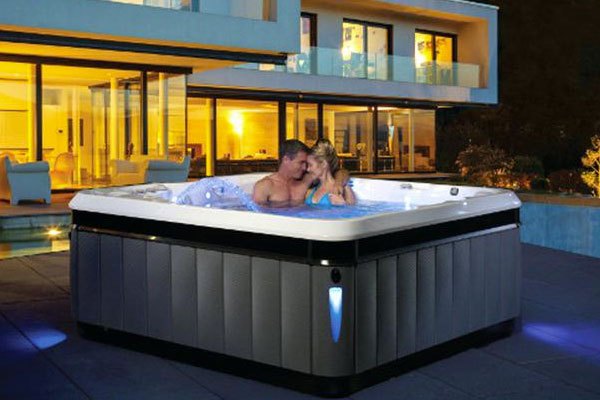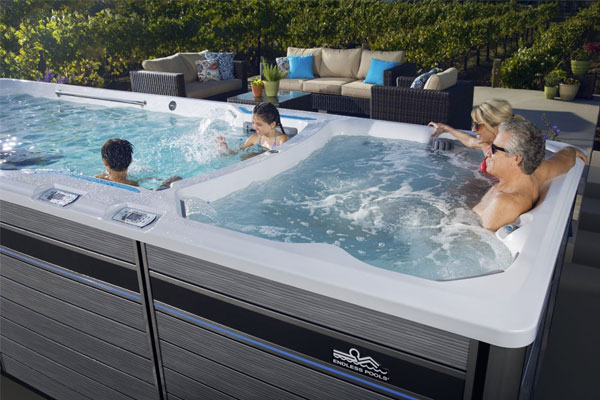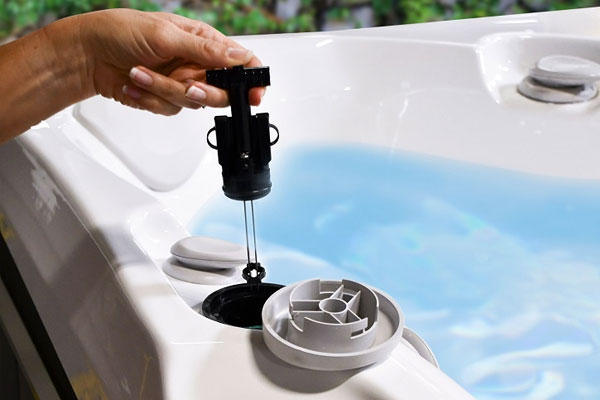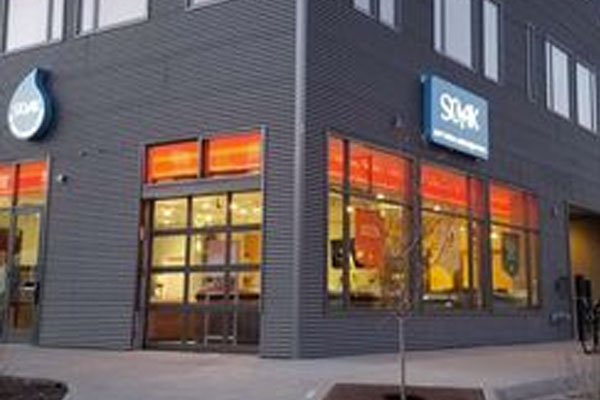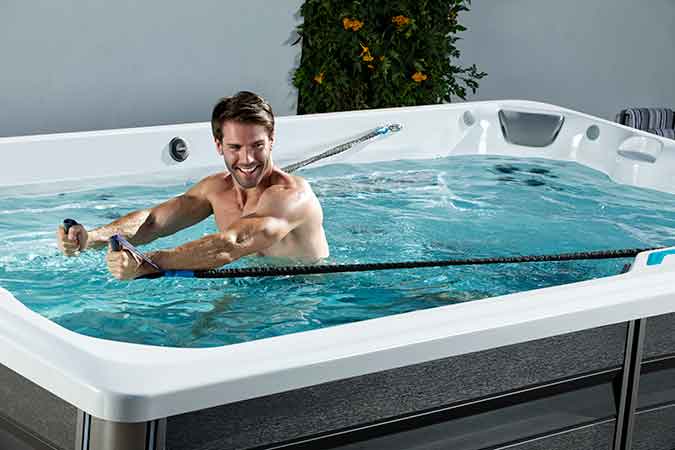
But the question remains… “How much does an endless pool cost?”
Today we’re diving into the answer to that question, as well as a host of other info about the various benefits and specifications of an endless pool!
How They Work
An endless pool is a swimming pool designed for small spaces that allows you to swim “endlessly” against a current, without ever having to turn around. Unlike traditional pools where you swim from one end to the other, an endless pool uses a powerful water flow system.
This system creates a steady current that you can swim against. And that makes it feel like you’re moving forward in open water, without actually changing positions.
It’s perfect for people who love to swim for exercise or relaxation but don’t have the space for a full-size pool. The current’s speed can be adjusted, so swimmers of all levels can use it.
This adjustable current is the heart of the endless pool. It allows for a swimming experience that can be tailored to your workout or relaxation needs.
Types of Endless Pools
There are several types of endless pools to consider, each with its own set of features.
Standalone models are the most straightforward option. These are above-ground pools that can be installed in various indoor or outdoor locations. They’re flexible and relatively easy to set up, making them a popular choice for those looking for convenience.
In-ground options offer a more integrated look. They blend seamlessly with your backyard or garden landscape. These pools require more initial work to install since they need to be built into the ground.
But the result is a beautiful and permanent addition to your home that feels like a natural part of your outdoor space.
Other Options
Dual-propulsion systems represent a step-up in endless pool technology. These pools have two separate currents, allowing two people to swim at different speeds simultaneously.
This feature is great for households with multiple swimmers or for those who want to add variety to their swimming routines. Dual-propulsion systems offer a more customizable experience, making sure everyone can swim at a pace that suits them.
Another interesting option is the swim spa. Swim spas are larger than typical endless pools and combine the features of a hot tub and an endless pool. They provide space for relaxation and hydrotherapy, alongside the benefits of an endless swimming current.
This makes them a versatile choice for those who want the best of both worlds: the relaxation of a hot tub and the fitness benefits of an endless pool.
Each type of endless pool offers unique benefits, depending on your needs and the space you have available. Whether you’re looking for a simple setup to dip into the world of endless swimming or a fully integrated system that caters to a range of activities, there’s an endless pool that’s right for you.
The key is to consider how you plan to use the pool, the space you have, and what features are most important to you.
Endless Pool Benefits
Owning an endless pool comes with a variety of benefits that touch on health, fitness, and overall lifestyle. One of the most significant advantages is the ability to swim laps without the need for a large traditional pool.
This makes swimming a convenient exercise option, even for those with limited space. Swimming is a low-impact workout that improves cardiovascular health, flexibility, and muscle strength. So, with an endless pool, you can enjoy all these health benefits right in the comfort of your own home.
From a fitness perspective, an endless pool offers a highly effective and versatile workout environment. The adjustable current allows for varied intensity levels. That makes it suitable for everyone from beginners to competitive athletes.
You can easily tailor your swimming sessions to focus on endurance, speed, or strength training. This adaptability also means that people recovering from injuries can use the pool for gentle rehabilitation exercises, gradually increasing the current’s strength as they regain mobility and strength.
More Benefits
Having access to a pool without leaving home means you’re more likely to incorporate swimming into your routine.
In that way, endless pools also contribute to a healthier lifestyle by providing a private, convenient, and stress-free swimming experience.
This accessibility is a game-changer for busy people or those who prefer the privacy of their home over public pools.
Endless pools also have technology to keep the overall experience quieter. This helps you focus on the fun of swimming. It’s done through sound-dampening materials that reduce the vibration and noise from the motors.
Plus, endless pools offer therapeutic benefits. Swimming or simply floating in the water can be a great way to relax and reduce stress.
The rhythmic nature of swimming, combined with the soothing properties of water, can help calm the mind and improve mental health. For families, an endless pool provides a fun and engaging way to spend time together, promoting an active lifestyle for all ages.
How Much Does an Endless Pool Cost?
When considering adding an endless pool to your home, one of the first questions that comes to mind is, “How much will it cost?” The price of endless pools can vary greatly depending on the model, size, and any additional features you choose.
To give you a clearer picture, let’s delve into the cost range for different endless pool options.
Entry-level standalone endless pools are the simplest models. They typically start at a price point that makes them accessible to a broad range of budgets. These models are above ground and can be installed in various settings, such as a backyard, garage, or sunroom.
Prices for these entry-level models can range from approximately $15,000 to $22,000. This range includes the basic swimming unit but doesn’t cover installation costs. These can vary based on your location and the specifics of your site.
Larger Investments
If you’re looking for something a bit more integrated into your home’s landscape or architecture, in-ground endless pools might be more your style. These pools are installed into a prepared pit and can be designed to blend seamlessly with your outdoor environment or indoor space.
The costs for in-ground models start higher than their standalone counterparts due to the additional construction work required. You can expect the price range for these pools to begin around $25,000 and can go up significantly depending on the size of the pool and the complexity of the installation process.
For those interested in a more luxurious or customized swimming experience, endless pools with dual-propulsion systems offer the ability to adjust the swim current independently on each side of the pool. These models start at around $30,000 and can increase in price with added customizations and size adjustments.
Due to their dual-function nature, swim spas are on the higher end of the price spectrum, typically starting at around $35,000. Like the other models, the final price can vary based on size, features, and installation requirements.
It’s also important to consider the ongoing costs associated with owning an endless pool, including maintenance, cleaning, and energy use.
However, these costs are generally offset by the convenience, health benefits, and enjoyment that an endless pool provides.
Installation Costs
When it comes to installing an endless pool, several factors can influence the overall cost. Understanding these can help you budget more accurately for your new pool.
First, the location where you plan to install your pool plays a significant role in determining the cost. If you choose to place it outdoors, considerations like the climate and land slope may require additional work. This could mean things like excavation and landscaping to prepare the site.
An indoor installation might seem simpler, but think about the need for adequate ventilation and humidity control. You also need to know whether your chosen room can support the weight of a full pool. Each scenario brings its own set of challenges and costs.
Groundwork is another crucial factor in installation costs. For an in-ground pool, excavation can be a major expense. This is especially true if the soil is difficult to dig through or if there’s a high water table in your area.
Even for above-ground models, you might need to prepare a flat, stable surface that can support the pool’s weight. This might involve pouring a concrete slab or constructing a sturdy deck, both of which can add to your expenses.
Other Installation Cost Factors
The accessibility of your installation site can impact the cost too. If your backyard is hard to reach or if getting the necessary equipment to the site is challenging, this can increase the price.
Contractors may need to use smaller, more maneuverable equipment or even manual labor to prepare the site. This can be time-consuming and costly.
Adding features to your endless pool can also affect the installation cost.
Options like underwater lighting, heaters, jets for hydrotherapy, or a counter-current system can enhance your swimming experience. But they’ll require additional equipment and labor to install. Each feature adds to the complexity of the project and, consequently, to the cost.
Lastly, local regulations and the need for permits can influence your installation budget. Depending on where you live, you may need to get approval from local authorities before you can install your pool.
This process might involve fees for permits and inspections to ensure the pool meets safety and zoning standards. It might even require changes to your initial plan to comply with local regulations.
Optional Features and Their Costs
Adding optional features to an endless pool can turn a simple swimming area into a personalized aquatic fitness and relaxation center. Each feature, from underwater treadmills to hydrotherapy jets, enhances your swimming experience. But they also impact the overall cost of your pool.
Underwater treadmills are a popular option for those looking to combine swimming with walking or running exercises. This feature is especially valuable for low-impact, cardiovascular workouts and rehabilitation activities.
Installing an underwater treadmill involves additional mechanical and electrical components. This can significantly increase the initial cost of your endless pool. But the benefits of being able to exercise in water, reducing stress on joints while improving strength and endurance, often justify the investment.
Hydrotherapy jets are another sought-after feature. They add to the cost but also greatly enhance the pool’s therapeutic capabilities. These jets can be adjusted to target specific areas of the body, providing relief for muscle soreness and improving circulation.
Installing hydrotherapy jets requires additional plumbing and pump systems to manage the water flow. This leads to an increase in the overall price. Despite the extra cost, the health and relaxation benefitsmake hydrotherapy jets a worthwhile addition for many owners.
Other Options
Lighting is not just an aesthetic addition. It also extends the usability of your endless pool into the evening. LED lights are energy-efficient and come in various colors, allowing you to create a tranquil ambiance for night swims.
The cost of adding lighting to your pool varies depending on the number and type of lights you choose. While not as significant as some of the other features, the wiring and installation of lights do contribute to the total cost.
Each of these optional features comes with its own set of installation and maintenance requirements, contributing to the overall investment in your endless pool. While they increase the initial cost, they also significantly enhance the functionality, enjoyment, and health benefits of your pool.
When considering these features, it’s important to balance the desire for a fully equipped pool with the reality of your budget.
Endless Pool Maintenance
Keeping an endless pool in top condition requires regular maintenance. This includes tasks like cleaning and chemical treatment. These ensure the water remains healthy and the pool’s systems run smoothly.
Cleaning your pool is a task that you can’t skip. This involves skimming debris from the surface of the water, vacuuming the bottom to remove dirt and sediment, and brushing the walls to prevent algae growth.
Skimming should be done daily, especially if your pool is outdoors and exposed to falling leaves and other debris. Vacuuming and brushing are usually weekly tasks. But they might need to be done more often if the pool is used frequently.
Chemical treatment is another essential part of pool maintenance. The right balance of chemicals keeps the water safe for swimming by killing bacteria and other harmful organisms.
Testing the water regularly is important to ensure levels of chlorine, pH, and other chemicals are within the recommended range. If the tests show that the chemical balance is off, you’ll need to add the necessary chemicals to bring the water back to a safe state.
It’s generally a good idea to test the water at least once a week, although more frequent testing might be needed after heavy use or significant rainfall.
Maintaining the pool’s filtration system is crucial. This system keeps the water clear by removing small particles and debris. You should clean or replace the filter according to the manufacturer’s recommendations.
This might be as often as every few weeks or as infrequently as once a season, depending on the type of filter and how often the pool is used.
Seasonal Maintenance Tips
Taking care of an endless pool means adjusting your maintenance routine with the changing seasons, especially if you live in an area with harsh winters or extremely hot summers. Proper seasonal maintenance ensures that your pool remains in great condition year-round and is ready for use whenever you are.
Winter Prep for Cold Climates
If you live in a place with cold winters, protecting your pool from freezing is a top priority. Start by checking the pool’s heating system to make sure it’s functioning correctly. Keeping the water at a consistent temperature prevents freezing and the potential damage it can cause.
Next, consider installing a pool cover if you don’t plan on swimming during the winter. A cover not only keeps out debris but also helps maintain the water temperature.
And keep an eye on the water chemistry. Even if you’re not using the pool, it’s important to maintain the correct chemical balance to prevent algae growth and other issues that can arise in standing water.
Summer Care for Hot Weather
In areas with hot summers, battling evaporation and keeping the water cool are the main concerns. A pool cover can be useful in this situation as well. It reduces water loss due to evaporation and can help keep the pool cooler when it’s not in use.
You might also need to adjust the chemical levels more frequently in the summer. Hotter temperatures can lead to faster chemical degradation, meaning chlorine and other important chemicals won’t last as long in the water. Regular testing becomes even more critical to ensure the water stays safe and clean for swimming.
General Seasonal Adjustments
Regardless of the season, there are a few maintenance tasks that are always important.
For instance, cleaning the pool’s filter system is essential. Debris can accumulate more quickly during certain times of the year, like fall when leaves are falling, so you might need to clean the filter more often.
Also, regular checks on the pool’s hardware, like pumps and heating systems, are key to catching any potential issues before they become bigger problems.
Troubleshooting Common Issues
Every pool owner will likely face maintenance challenges at some point. Knowing how to tackle these issues can save time and money. Common problems include pump repair, liner replacement, and the need for system upgrades.
Pump Repair
The pump is the heart of your endless pool, circulating water and keeping the current flowing. When it malfunctions, it can bring your swimming routine to a halt.
Signs of pump trouble include unusual noises, decreased water flow, or the pump failing to start. Repair costs can vary widely, depending on the issue.
Minor repairs might only require replacing a seal or gasket, which is relatively inexpensive. However, more significant problems, such as a failed motor, can be costly. To avoid unexpected repairs, regular maintenance and prompt attention to any signs of wear or unusual behavior are important.
Liner Replacement
The liner of your pool not only keeps it looking good but also ensures it remains watertight. Over time, liners can suffer from wear and tear, leading to leaks.
Exposure to chemicals and sunlight can also degrade the liner material. Replacing a pool liner is a more significant expense. It involves draining the pool, removing the old liner, preparing the surface, and installing the new liner.
The cost depends on the pool size and liner quality. While this is not a frequent issue, budgeting for eventual liner replacement is a good idea.
System Upgrades
Upgrading your pool’s system might be necessary to improve efficiency, enhance safety, or expand functionality. This could include installing a more efficient heater or updating the filtration system. It might mean adding features like automated chemical feeders.
While upgrades require an upfront investment, they can lead to long-term savings in maintenance costs and energy bills. Plus, they can significantly improve your pool experience.
When considering upgrades, it’s important to weigh the initial cost against the benefits and potential savings.
Dealing with common pool issues promptly can prevent minor problems from turning into major expenses. Regular checks and maintenance are key to identifying potential problems early.
Setting aside a budget for repairs and upgrades can also help manage costs without surprise. Investing in your pool’s upkeep not only extends its life but also ensures it remains a source of health, fitness, and enjoyment.
Cleaning Routines and Tools
Maintaining water quality and hygiene in your endless pool requires a dedicated routine. On a daily basis, it’s important to skim the surface of the pool to remove leaves, insects, and other debris. This prevents the debris from sinking and making the pool dirty.
Using a hand skimmer makes this task easy and efficient. Also, take a moment each day to check the pool’s water level. If it’s too low, the pump might not work correctly, which can lead to bigger problems.
On a weekly basis, there are a few key tasks to keep your pool in top condition. Vacuuming the pool floor is essential to remove dirt and debris that have settled at the bottom.
A manual pool vacuum works well for this, but automatic or robotic pool cleaners can make the job much easier and are worth considering. Brushing the walls and floor of the pool is also important to prevent algae buildup.
Use a pool brush that’s compatible with the surface of your endless pool to avoid scratches.
Another weekly task is to check and adjust the water chemistry. Testing kits are available to measure chlorine, pH, and other chemical levels in the water.
Based on the results, you might need to add chemicals to keep the water balanced and safe for swimming. Proper water chemistry prevents bacteria and algae growth, ensuring the water stays clear and healthy.
Specialized Cleaning Products and Tools
When it comes to cleaning products and tools, using those specifically designed for endless pools can significantly improve the cleaning process and overall pool maintenance. For instance, a telescopic pole with interchangeable heads for skimming, brushing, and vacuuming can be a great investment.
It allows you to easily switch between tasks without needing multiple separate tools.
For vacuuming, there are several options tailored for small to medium-sized pools like endless pools. Robotic cleaners are efficient and require little effort on your part. They can be more expensive than manual vacuums, but their ability to scrub and vacuum the pool floor and walls autonomously makes them a valuable addition to your cleaning routine.
When it comes to chemicals, it’s crucial to use products that are safe for endless pools. Chlorine is commonly used for sanitization. But there are also alternative sanitizers like bromine, which can be gentler on skin and eyes. Be sure to follow the manufacturer’s guidelines for your specific pool type. That will help make sure you’re using the correct amounts and types of chemicals.
Algaecides and clarifiers are other specialized products that can keep your pool water clear and free of algae. While not always necessary, they can be helpful in maintaining water quality, especially during warmer months when algae growth is more likely.
In terms of cost, investing in quality cleaning tools and products can save money in the long run by keeping your pool in good condition and preventing issues that could lead to expensive repairs.
While some items, like robotic cleaners, might seem like a significant upfront expense, their effectiveness and convenience can outweigh the cost over time.
Hiring Professional Pool Cleaning Services
Deciding to use professional pool cleaning services for your endless pool comes with its own set of benefits and drawbacks. One of the main advantages is the convenience it offers.
Professional cleaners take the hassle out of maintaining your pool, saving you time and ensuring that the job is done correctly. They have the expertise to handle complex maintenance tasks. This runs from balancing the water chemistry to deep cleaning, which might be challenging for pool owners to do on their own.
Another benefit is the potential for longer pool life. Professionals can spot and address minor issues before they turn into costly repairs. This helps extend the lifespan of your pool. Regular professional maintenance can keep your pool’s systems running efficiently and prevent wear and tear.
But there are also downsides to consider. The cost is a significant factor. Hiring professional services can be expensive, especially if you opt for frequent cleanings or require specialized maintenance tasks.
The price can vary widely depending on the services you need, the size of your pool, and your location, but it’s generally a recurring expense that pool owners need to budget for.
Frequency is another consideration. Some pool owners might need professional services weekly to keep their pool in pristine condition. Others may find that a monthly or even seasonal service meets their needs.
The right frequency will depend on how often the pool is used, the environment (such as trees that drop leaves into the pool), and how much of the routine maintenance the owner is willing to do themselves.
Comparing Endless Pool Costs to Traditional Pools
When deciding between an endless pool and a traditional swimming pool, understanding the long-term costs is key. Both types of pools offer great benefits for fitness and leisure.
But they come with different price tags over time. This is especially true when you consider maintenance, cleaning, and utility costs.
Endless pools are known for their compact size and innovative design. For starters, the smaller volume of water in an endless pool requires fewer chemicals for maintenance and less energy for heating, leading to lower monthly expenses. And the contained design of endless pools often results in less debris, which means less frequent cleaning and lower costs for cleaning supplies.
Traditional swimming pools, with larger surface areas and volumes, demand more in terms of maintenance and cleaning. The bigger the pool, the more chemicals and water are needed to keep it clean and safe for swimming.
Heating a traditional pool can significantly increase utility bills, since more water volume requires more energy to warm.
Furthermore, traditional pools often require professional opening and closing services at the beginning and end of the swimming season, which adds to the annual costs.
Energy Efficiency and Savings
Endless pools stand out for their energy efficiency, which translates into significant cost savings over time, especially in terms of heating and filtration systems. Traditional swimming pools require large amounts of energy to heat a vast volume of water. But endless pools are typically smaller and can be covered when not in use.
This design minimizes heat loss, making it far more energy-efficient to maintain a comfortable water temperature.
The heating systems used in endless pools are often state-of-the-art. They’re designed to heat water quickly and maintain temperature efficiently. This is vital in cooler climates or for those who want to use their pool year-round.
The reduced volume of water in an endless pool, compared to traditional pools, means less energy is needed for heating, which directly leads to lower utility bills.
Filtration is another area where endless pools shine in terms of energy efficiency. The filtration systems in these pools are optimized for the smaller volume of water. They require less power to circulate and clean the pool.
Modern endless pools often incorporate advanced filtration technologies that operate more efficiently than those found in larger pools, further reducing energy consumption.
Plus, the ability to easily cover an endless pool when it’s not in use helps maintain water temperature and quality. This not only reduces the energy needed for heating but also decreases the frequency of filtration and chemical treatment, contributing to lower operational costs.
Impact on Property Value
Adding an endless pool to a property is an investment in the property’s value and appeal.
When it comes to selling a home, unique features like an endless pool can make a property stand out in the real estate market, potentially increasing its value and attracting more buyers.
One reason an endless pool can boost property value is its appeal to a wide range of buyers. For fitness enthusiasts, the convenience of being able to swim laps at home, regardless of the property’s size, is a huge draw.
Families might see it as a perfect way for kids to play and learn to swim in a safe, controlled environment. Older buyers or those with mobility issues might be attracted to the therapeutic benefits of water exercise without the need for travel.
The modern, compact design of endless pools, combined with their energy efficiency, aligns well with current trends in home buying.
People are increasingly looking for homes that offer both luxury and sustainability. An endless pool fits this niche perfectly. It suggests a lifestyle that is both health-oriented and environmentally conscious, traits that are becoming more important to today’s homebuyers.
Of course, the added value depends on the local market and the demographics of potential buyers. In areas where outdoor activities and fitness are highly valued, an endless pool could significantly increase a property’s appeal.
But in markets where outdoor space is more prized for other uses, such as gardening or traditional landscaping, the impact might be less pronounced.
Financing Options Available
Investing in an endless pool is a significant decision that comes with its share of costs. Thankfully, there are several financing options available to help make this investment more manageable.
One common way to finance an endless pool is through personal loans. Many banks and credit institutions offer personal loans that can be used for home improvement projects, including the installation of an endless pool.
The advantage of a personal loan is its straightforwardness. You borrow a specific amount and pay it back with interest over a predetermined period. The interest rate and terms will vary based on your credit score and the lender’s policies.
Another option is a home equity line of credit (HELOC). If you have equity in your home, a HELOC allows you to borrow against it. This option often comes with lower interest rates compared to personal loans because the loan is secured by your home.
It’s a flexible option too, as you can draw from the line of credit as needed up to the limit, and interest is only charged on the amount you use.
Manufacturer financing programs can also be a viable option. Some endless pool companies offer financing plans to make their products more accessible.
These programs can vary widely in terms of interest rates and repayment terms, so it’s important to carefully review the details. Some manufacturers may offer promotional financing with low or no interest for a certain period. This is an attractive option if you can pay off the loan within the promotional period.
Budgeting for Your Endless Pool
Budgeting for your endless pool involves careful planning and consideration, not just for the initial purchase but also for the ongoing maintenance costs. Setting aside funds and creating a budget plan can help make the dream of owning an endless pool a reality without causing financial strain.
First, start by researching the total cost of the endless pool you’re interested in, including installation and any optional features you may want. Once you have a clear idea of the total cost, you can begin to plan how to save for this amount.
One approach is to set up a dedicated savings account specifically for your endless pool project.
Contributing a set amount of money each month can help you gradually build up the necessary funds. Treat this savings goal like any other financial obligation, prioritizing it in your budget.
In addition to saving for the purchase and installation costs, it’s important to consider the ongoing maintenance expenses. These can include costs for cleaning, chemical treatments, and energy for heating.
Estimating these costs in advance can help you understand the total financial commitment you’re making. Setting aside a small portion of your budget each month into a maintenance fund can prevent unexpected expenses from becoming a financial burden.
Consider also the timing of your purchase. Prices and demand for endless pools can vary throughout the year. You might find that purchasing during the off-season could offer cost savings. Plus, some companies offer financing plans or promotions, which can make the purchase more manageable by spreading the cost over time.
Endless Pools Can Be Endless Fun!
You now have some answers to your question, “How much does an endless pool cost?”
As you can see, there are a ton of factors that can change the overall cost, so a lot will depend on your needs and choices.
At Soak Hot Tubs and Endless Pools, we design and carefully construct a product with extraordinary benefits that can bring positive change and help transform your life. Get in touch today to find out how we can help!
